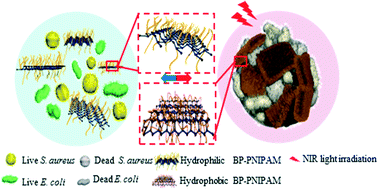Thermo-responsive polymer–black phosphorus nanocomposites for NIR-triggered bacterial capture and elimination†
Abstract
Water contamination by pathogenic bacteria is a major challenge to human health. The conventional disinfection methods produce disinfection by-products that may be carcinogenic, while the recently-developed nanotechnologies face the difficulties of low efficiency and rate, secondary pollution, and tedious processes. To solve these problems, we designed a thermo-responsive poly(N-isopropylacrylamide)-functionalized black phosphorus (named BP–PNIPAM) to capture and eliminate bacterial cells under the stimuli of near-infrared (NIR) irradiation. PNIPAM is covalently linked to the surface of BP nanosheets by aryl diazonium reaction and in situ atom transfer radical polymerization (ATRP). Under short-time NIR irradiation, bacterial cells are captured and co-precipitated with BP–PNIPAM due to the thermally induced hydrophilic-to-hydrophobic phase transition of PNIPAM. If the irradiation time is prolonged, the wrapped bacteria are disinfected due to hyperthermia. More than 80% of E. coli and S. aureus are captured by 100 μg mL−1 BP–PNIPAM within 5 min-NIR irradiation, while the elimination efficiency towards E. coli, S. aureus, and anti-ampicillin E. coli reaches 100% in the presence of 50 μg mL−1 BP–PNIPAM within 20 min-NIR irradiation. Moreover, BP–PNIPAM exhibits no obvious toxicity to Caco-2 cells up to 100 μg mL−1 within 24 h. Therefore, BP–PNIPAM offers an efficient, biocompatible, and convenient approach for the capture and sterilization of pathogenic bacteria in water.



 Please wait while we load your content...
Please wait while we load your content...